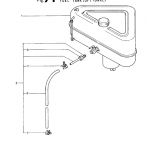B58
Well-Known Member
I think your issue is down the tank, if you have the slightest air leak fuel will run back into the tank. Check the lift pump valves for debris it could hold the valve open. you could fit an outboard style hand primer which would assist the little lift pump, it also has a one way valve installed.
What i would do, is to use a remote tank, and directly feed into the fuel injection pump, by-passing the fuel filter and lift pump.
Run your engine until to temperature, and leave it overnight, check again in the morning.
Yanmar intended for the engine to use a gravity fuel tank of 30 liters due to the engines tiny fuel consumption of around 0.2l/hr.
These tanks are like hens teeth, however, if you could have a 10 l fuel tank fabricated and use that as a day tank.

What i would do, is to use a remote tank, and directly feed into the fuel injection pump, by-passing the fuel filter and lift pump.
Run your engine until to temperature, and leave it overnight, check again in the morning.
Yanmar intended for the engine to use a gravity fuel tank of 30 liters due to the engines tiny fuel consumption of around 0.2l/hr.
These tanks are like hens teeth, however, if you could have a 10 l fuel tank fabricated and use that as a day tank.

